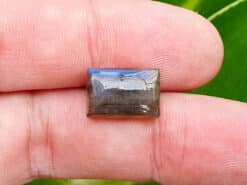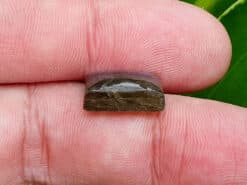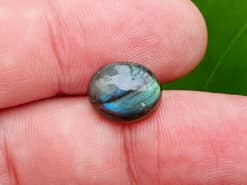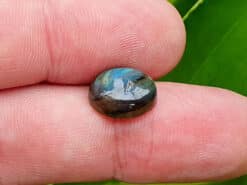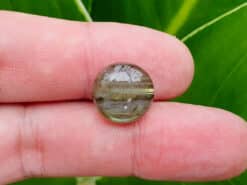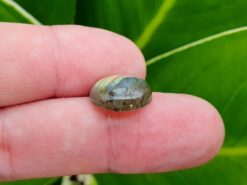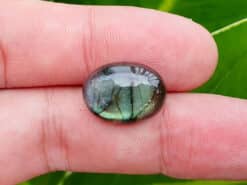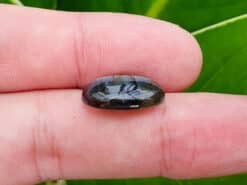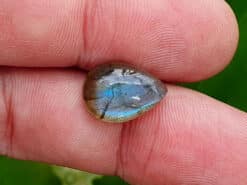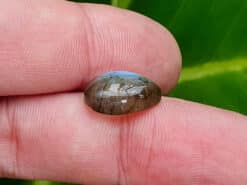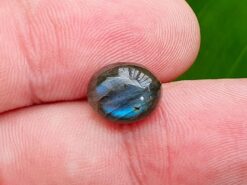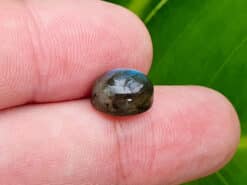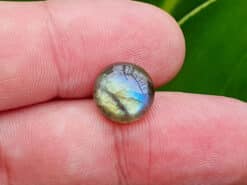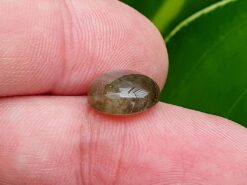Labradorite
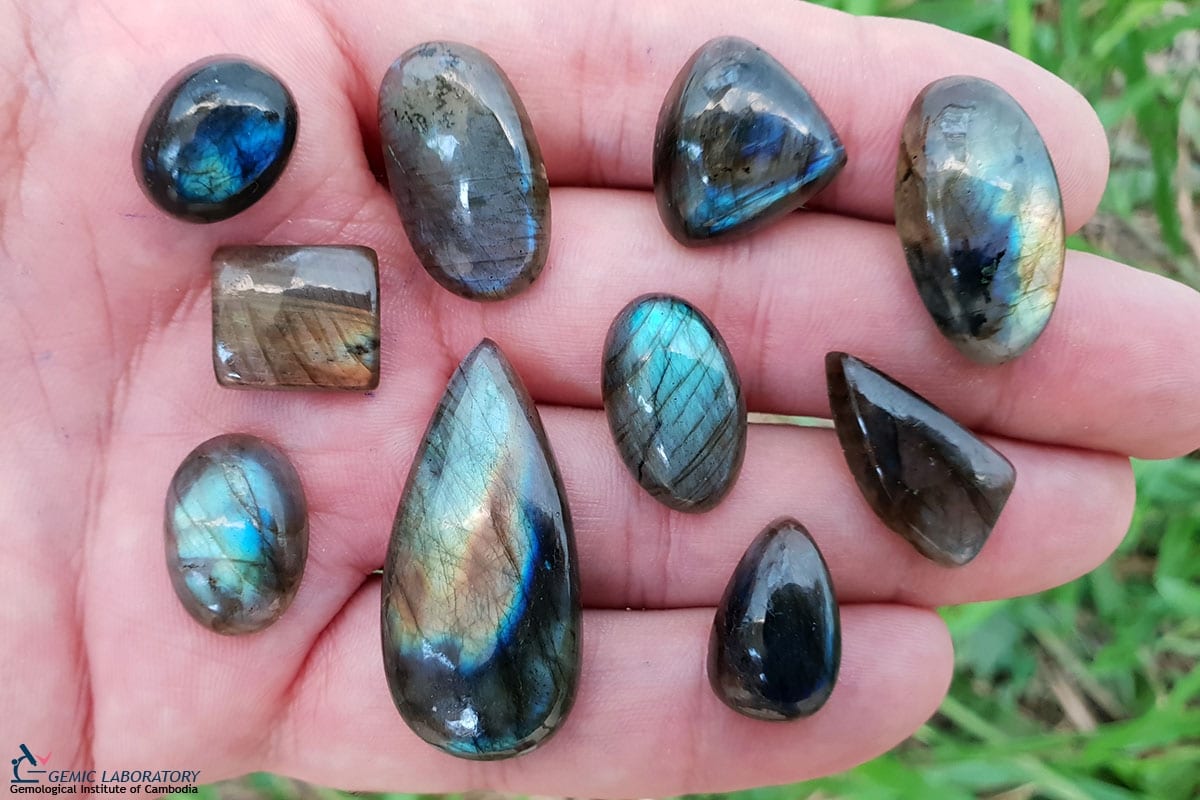
Labradorite crystal stone meaning and metaphysical properties
Buy natural labradorite in our shop
Labradorite properties
Labradorite is a notable variety of feldspar, specifically an intermediate to calcic member of the plagioclase series. Its composition typically includes an anorthite percentage between 50% and 70%. With a specific gravity ranging from about 2.68 to 2.72, labradorite often displays a white streak, similar to most silicate minerals. Its refractive index spans approximately from 1.559 to 1.573, and twinning is common due to its triclinic crystal structure. The stone features three directions of cleavage, two of which are nearly perpendicular and of good to perfect quality, while the third is poorer. These characteristics influence how the stone can be cut and polished for use in decorative and ornamental applications.
In its natural geological setting, labradorite commonly appears as clear, white, or gray blocky to lath-shaped grains in mafic igneous rocks such as basalt and gabbro. It can also occur in anorthosite formations, in which it can be the primary feldspar mineral. Additionally, labradorite is sometimes found in metamorphic environments like amphibolites and within certain sedimentary deposits as a detrital component. Associated minerals in its host rocks often include olivine, pyroxenes, amphiboles, and magnetite. Together, these associations and its broad geological distribution have contributed to the stone’s importance both scientifically and aesthetically.
Formation and geological environment
The geological type area for labradorite is Paul’s Island, near the town of Nain in Labrador, Canada. The region’s ancient geological history, marked by slow cooling of magma chambers, created ideal conditions for labradorite formation. Over extended periods, elemental diffusion allowed calcium, sodium, aluminum, and silicon to arrange themselves into the lamellar structures that grant labradorite its most famous optical properties. Beyond Canada, significant deposits have been identified in countries such as Norway and Finland, demonstrating that labradorite’s formation is not confined to a single locale but rather can occur wherever suitable geologic processes have taken place. This global availability ensures that people worldwide can appreciate and utilize this remarkable mineral.
Labradorescence
One of the most captivating features of labradorite is its unique optical effect known as labradorescence. Coined by Ove Balthasar Boggild, the term “labradorization” describes the distinctive reflections of light from submicroscopic planes within the mineral’s structure. These tiny lamellae, oriented in one or sometimes two directions, interact with incoming light to produce a vivid, iridescent play of colors that shift when viewed from different angles. The phenomenon arises from a complex interplay of mineral chemistry and structural order, specifically phase exsolution lamellar structures that form during very slow cooling of the host rock.
When the lamellar separations measure between approximately 128 and 252 nm, the resulting diffraction leads to vibrant blues, greens, golds, and occasionally even spectral hues. While not all labradorite stones exhibit this property to a high degree—some may have cooled too quickly or lack the ideal composition—those that do often command considerable attention in the gemstone market. Gem-quality stones that exhibit exceptionally strong labradorescence are sometimes referred to as spectrolite, highlighting their intense color play.
Historical and cultural significance
Throughout history, labradorite’s mesmerizing flashes of color have captivated observers and sparked legends. Indigenous peoples living in regions where labradorite is found have sometimes incorporated it into cultural practices or spiritual traditions, viewing the stone as an embodiment of the natural world’s mystical qualities. Folklore holds that the radiant blues and greens within labradorite’s depths were trapped lights from the aurora borealis, lending it a cosmic significance. This association with the northern lights and celestial energies endows labradorite with a mythic quality that resonates with many who seek to connect their earthly experiences with the grandeur of the universe.
How to use labradorite in daily life
In everyday practice, labradorite can be incorporated in various ways. Some individuals choose to wear labradorite jewelry as a constant reminder of their intentions—whether that’s staying grounded, seeking clarity, or nurturing self-confidence. Others may place tumbled labradorite stones in their living spaces to foster an atmosphere of calm and balance. Meditating with labradorite is another popular method, holding the stone in one’s hand or placing it on the body to encourage a gentle flow of intuitive insights. Over time, personal experiences and interactions with labradorite can help users develop their own meaningful interpretations of this versatile crystal.
Tips for caring for your labradorite
To maintain labradorite’s natural beauty, gentle care is recommended. Clean the surface with a soft, damp cloth, avoiding harsh chemicals or abrasive cleaners that may dull its polish. Although labradorite can tolerate brief contact with water, prolonged immersion is not advised, as it may weaken the stone over time. Store labradorite separately from other crystals or jewelry to prevent scratches, as it is not as hard as materials like quartz. By treating your labradorite with mindful care, you can preserve its aesthetic and energetic qualities for many years to come.
Labradorite meaning and metaphysical properties
The following section is pseudo scientific and based on cultural beliefs.
Labradorite crystal stone meaning and metaphysical properties center around transformation, protection, and heightened spiritual awareness. Many cultures and traditions view labradorite as a shield for the aura, believed to guard against unwanted energies and negative influences from the outside world. By creating an energetic boundary, the stone is said to help maintain emotional balance and inner peace. Labradorite can also be seen as a tool for self-reflection, encouraging one to confront and temper negativity within the self, thereby promoting growth and positive change.
In metaphysical circles, labradorite is frequently associated with deepening intuition, enhancing psychic abilities, and facilitating connection to higher realms of consciousness. By working with this stone, practitioners believe it can help attune the user to subtle energetic frequencies, opening pathways to insights that may otherwise remain hidden. In this way, labradorite’s meaning transcends mere aesthetics and enters the domain of personal development, spiritual exploration, and the pursuit of inner wisdom. Although these interpretations have no scientific basis, they remain a cherished aspect of the stone’s cultural narrative.
FAQ
What are the healing properties of labradorite?
A stone of transformation, labradorite is considered a useful companion through change, believed to impart strength and perseverance. It is said to balance and protect the aura, raise consciousness, and ground spiritual energies. Many believe it strengthens intuition and promotes heightened psychic abilities.
What are the benefits of labradorite?
Enthusiasts claim that labradorite enhances intuition and encourages trust in oneself and the universe. It may banish fears, calm an overactive mind, and foster creativity, thus helping to develop new ideas and a renewed sense of enthusiasm.
What chakra is labradorite good for?
Many practitioners associate labradorite with the throat chakra. As a stone of transformation and communication, it is believed to stimulate clear expression and authentic voice, supporting personal development and honest self-reflection.
Can I wear labradorite every day?
Labradorite jewelry can be worn daily as a fashionable accessory. Doing so may help one remain attuned to the stone’s energies, allowing for ongoing interaction with its supportive and protective qualities.
Which hand should wear labradorite?
Some traditions suggest wearing labradorite on the ring finger of the dominant hand. For right-handed individuals, this means the right hand, and for left-handed individuals, the left hand. The stone is often worn on a Friday evening during the Shukla Paksh.
Can labradorite go in water?
Labradorite is slightly sensitive to water. While a quick rinse is generally safe, prolonged exposure—such as leaving it submerged in a pool—can cause deterioration. Use caution and dry it promptly after cleaning.
How can you tell fake labradorite?
Genuine labradorite exhibits a dynamic play of color when viewed from different angles. Fake or imitation stones often lack this changeability, appearing constantly colorful or dull and not shifting hue in response to angle changes.
Does labradorite scratch easily?
With a hardness of about 6 to 6.5 on the Mohs scale, labradorite is softer than quartz. As dust often contains quartz, it can scratch labradorite. Handle the stone gently and avoid rough or abrasive materials.
Does labradorite fade in the sun?
Prolonged exposure to intense sunlight can lead to fading or damage in some stones. While labradorite tolerates moderate light, it is best to avoid leaving it in direct sunlight for extended periods to preserve its iridescent sheen.
Where should you place a labradorite stone in your home?
Many place large labradorite specimens in living rooms or communal areas, believing the stone cleanses negative energies. This placement is thought to maintain a harmonious atmosphere, leaving everyone feeling more balanced and calm.
Is labradorite a lucky stone?
Labradorite is often regarded as a mystical protector, symbolizing the interplay of sun and moon energies. Some associate it with ensuring success and promoting positive changes, thus considering it a stone of good fortune.
Is labradorite the same as moonstone?
Though related as feldspar minerals, labradorite and moonstone differ in composition. Labradorite is a calcium sodium feldspar, whereas moonstone is a potassium sodium feldspar. While considered “sister stones,” they remain distinct gemologically.
Why does labradorite glow?
Labradorite’s glow is caused by labradorescence. Internal microscopic structures reflect light back and forth, dispersing it into various colors. This optical effect makes labradorite’s appearance so striking and memorable.
Natural labradorite for sale in our gem shop
We make custom labradorite jewelry, including engagement rings, necklaces, stud earrings, bracelets, and pendants. Please contact us for a quote.

